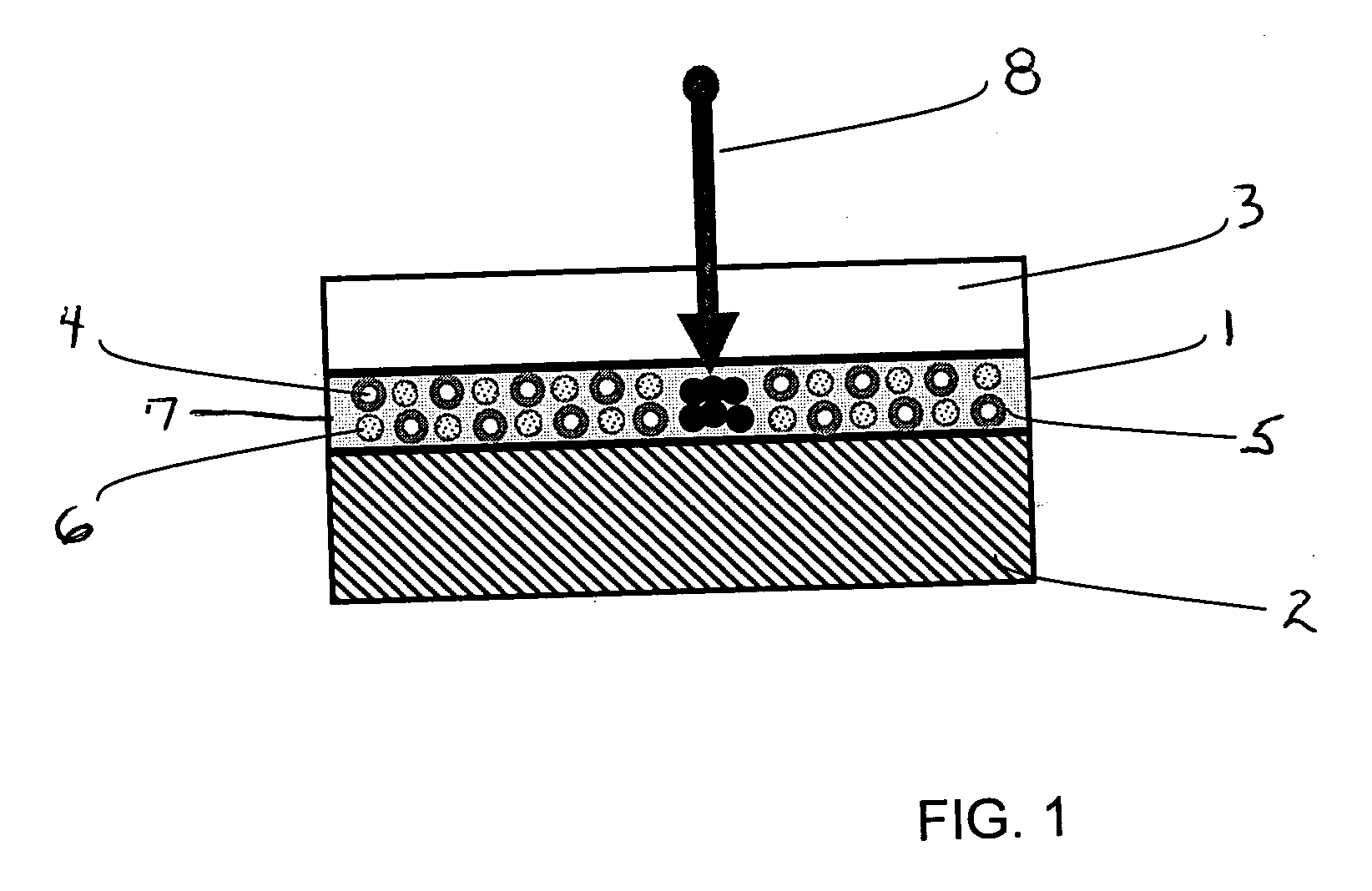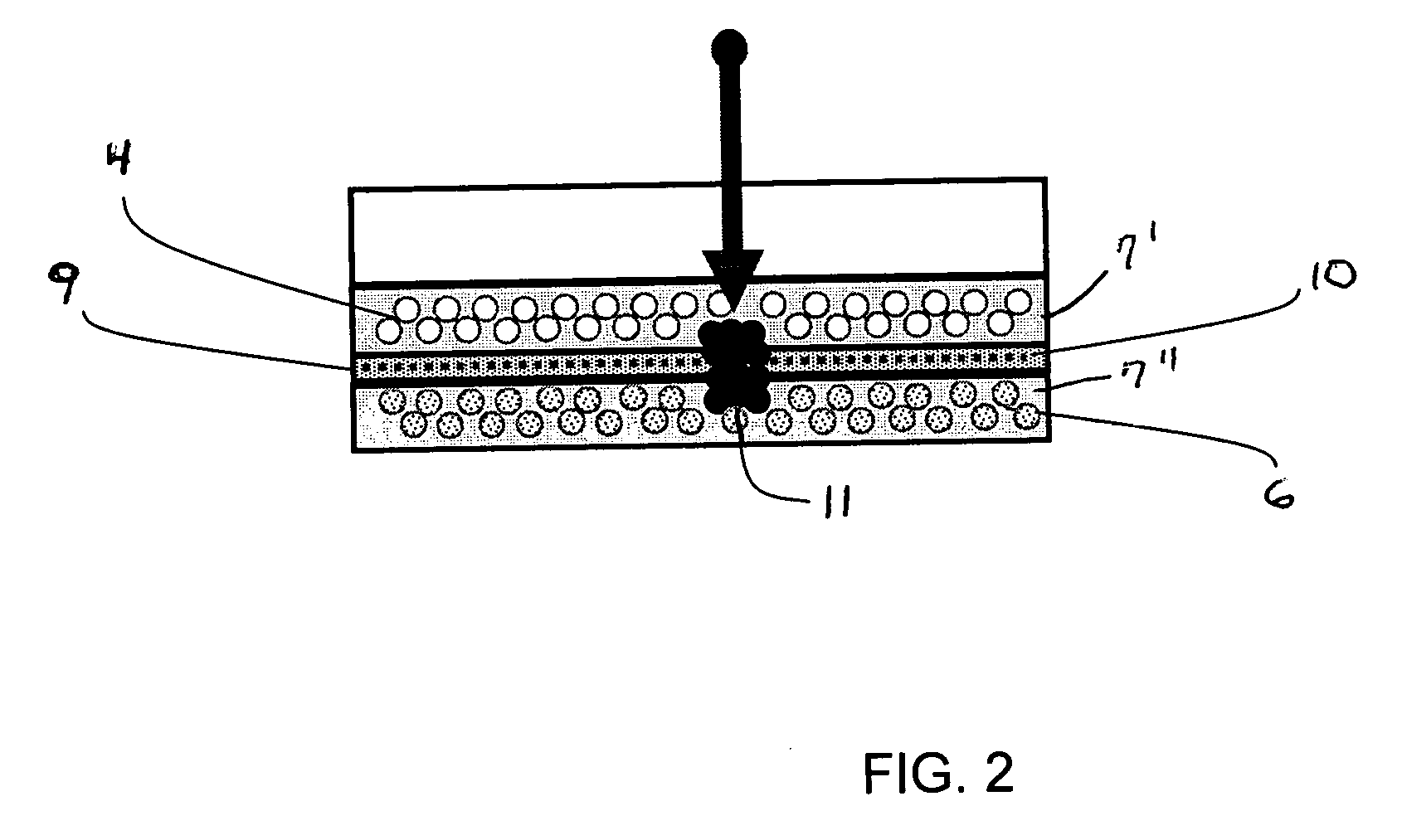Media providing non-contacting formation of high contrast marks and method of using same, composition for forming a laser-markable coating, a laser-markable material and process of forming a marking
- Summary
- Abstract
- Description
- Claims
- Application Information
AI Technical Summary
Benefits of technology
Problems solved by technology
Method used
Image
Examples
example 1
[Preparation of Liquid Dispersion (A) Containing an Encapsulated Electron Donor Dye Precursor]
[0168] 13.3 g of electron donor dye precursor represented by Formula (1), where R1 is C4H9 and R2 is C2H5, and 0.47 g of an UV light absorbing agent (trade name: Tinuvin P, Ciba Geigy Corp.) were added in 20 g of ethyl acetate and dissolved by heating up to 70° C., and then cooled down to 45° C. 12.6 g of diisocyanate compound (trade name: Takenate D-140N, Mitsui Takeda Chemical Co., Ltd.) was added into the ethyl acetate solution. The above ethyl acetate solution was then added into 53 g of 6%w / w polyvinyl alcohol aqueous solution (trade name: Kuraray Poval MP-217C, Kuraray Co., Ltd.) and emulsified with a homogenizer for 5 minutes. Finally, an amine solution of 90 g water and 0.5 g of tetraethylenepentamine were gradually added into the above mixture while agitating at 60° C. for 4 hours to conduct an encapsulation reaction.
[0169] After the reaction was completed, the particle size dist...
example 2
[0175] For reference, the following Table 1 lists electron donor dye precursor compounds, and includes the corresponding solubility in ethyl acetate, which are used in the following examples.
TABLE 1Solubility inethyl acetateDye(g / 100PrecursorStructuregrams)D-1Formula (1), when R1 is C4H9 and R2 is C2H518D-2Formula (4)5D-3Formula (5)4D-4Formula (2)60D-5Formula (3)20D-6Formula (6)5Formula (4)Formula (5)Formula (6)
example 2-1
[Preparation of Liquid Coating Composition Containing an Encapsulated Electron Donor Dye Precursor]
Sample 1 (Comparison)
[0176] 13.3 g of electron donor dye precursor D-1 and 0.47 g of an UV light absorbing agent (trade name: Tinuvin P, Ciba Geigy Corp.) were added in 20 g of ethyl acetate and dissolved by heating up to 70° C., and then cooled down to 45° C. 14.1 g of capsule wall material W-1 (trade name: Takenate D-127N, Mitsui Takeda Chemical Co., Ltd.) and 2.5 g of capsule wall material W-2 (trade name: Takenate D-110N, Mitsui Takeda Chemical Co., Ltd.) were added to the ethyl acetate solution.
[0177] The above ethyl acetate solution was added to 53 g of 6% w / w polyvinyl alcohol aqueous solution B-1 (trade name: Kurary Poval MP-217C, Kuraray Co., Ltd.) and emulsified with a homogenizer for minutes.
[0178] 90 g of water and 0.75 g of tetraethylenepentamine were added and mixed with a stirrer at 60° C. for 4 hours for encapsulation reaction.
[0179] After the reaction was complet...
PUM
| Property | Measurement | Unit |
|---|---|---|
| Temperature | aaaaa | aaaaa |
| Temperature | aaaaa | aaaaa |
| Temperature | aaaaa | aaaaa |
Abstract
Description
Claims
Application Information
 Login to View More
Login to View More - R&D
- Intellectual Property
- Life Sciences
- Materials
- Tech Scout
- Unparalleled Data Quality
- Higher Quality Content
- 60% Fewer Hallucinations
Browse by: Latest US Patents, China's latest patents, Technical Efficacy Thesaurus, Application Domain, Technology Topic, Popular Technical Reports.
© 2025 PatSnap. All rights reserved.Legal|Privacy policy|Modern Slavery Act Transparency Statement|Sitemap|About US| Contact US: help@patsnap.com



